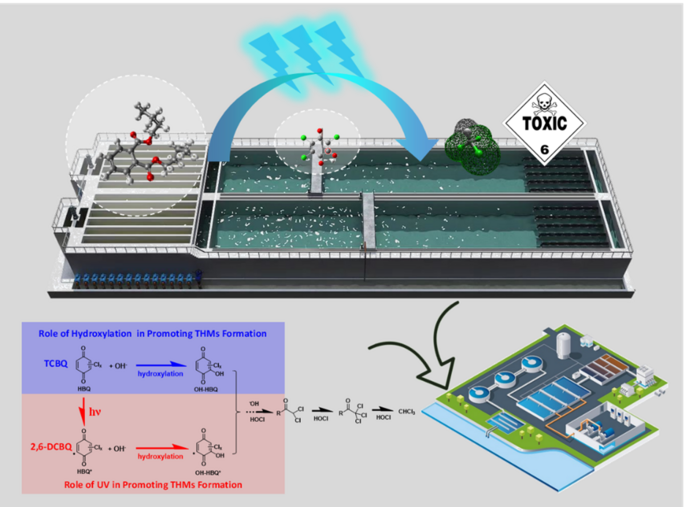Ultraviolet (UV) irradiation has been an alternative disinfection technology for water treatment over the past few decades. Compared to conventional free chlorine disinfectant, a combination process of chlorine and UV may enhance the disinfection efficacy of chlorination and lower the demand for applied chlorine dose in water treatment. It has been reported that UV disinfection followed by chlorination is applied at more than 28 drinking water treatment plants in the United States. UV treatment has also been increasingly applied to chlorinated swimming pool waters as a secondary disinfection process and a chloramine control strategy.

Credit: He Zhao, Ching-Hua Huang, Chen Zhong, Penghui Du, Peizhe Sun
Ultraviolet (UV) irradiation has been an alternative disinfection technology for water treatment over the past few decades. Compared to conventional free chlorine disinfectant, a combination process of chlorine and UV may enhance the disinfection efficacy of chlorination and lower the demand for applied chlorine dose in water treatment. It has been reported that UV disinfection followed by chlorination is applied at more than 28 drinking water treatment plants in the United States. UV treatment has also been increasingly applied to chlorinated swimming pool waters as a secondary disinfection process and a chloramine control strategy.
Halobenzoquinones (HBQs), as new emerging disinfection by-products (DBPs), are frequently detected in potable and swimming pool waters. In fact, HBQs are also precursors of other DBPs such as currently regulated trihalomethanes (THMs), which pose a high risk to the public health and the environment. When UV is applied during the chlorination process, the DBPs formation may be quite different from that under chlorine alone or UV alone. However, there remain many questions that require further investigation. For instance, does UV/chlorine combined disinfection promote or limit the transformation of HBQs into DBPs compared with chlorine-only disinfection? Particularly, does UV play a significant role in the transformation of organic precursors and the formation of DBPs upon chlorine disinfection?
To answer these questions, Prof. Ching-Hua Huang from the Georgia Institute of Technology, Dr. He Zhao from the Institute of Process Engineering Chinese Academy of Sciences and their team members have worked jointly and revealed systematically the molecular mechanism of THMs produced from HBQs in chlorination or combined UV/chlorine. Their work identified the promoting effect of UV on HBQs in THMs formation, which provided valuable insight for the potential risk during the application of combined UV/chlorine in water treatment. This study entitled “Enhanced formation of trihalomethane disinfection byproducts from halobenzoquinones under combined UV/chlorine conditions” is published online in Frontiers of Environmental Science & Engineering in 2022.
In this study, the research team found UV enhanced by nearly 10 times the CHCl3 formation yield of 2,6-dichloro-1,4-benzoquinone (2,6-DCBQ, one of the most frequently detected HBQs in drinking water). They also conducted in-depth investigation of the reaction mechanism using complimentary experimental measurements and density functional theory (DFT) calculations, and revealed different formation patterns of THMs from four species of HBQs during chlorine-only and UV/chlorine processes. Their Investigation showed that UV had a great influence according to the chemical structure of HBQs, directly affecting the hydrolysis rate, transformation pathways, intermediates, and the subsequent production of THMs. Their results also unveiled the hydroxylation of HBQ to be a key intermediate pathway in promoting THMs formation.
This study investigated comprehensively and systematically the formation of THMs from HBQs during chlorination or combined UV/chlorine processes for the first time, which should be considered in the application of combined UV and chlorine processes in water treatment. It has deepened our understanding of the promoting roles of UV irradiation and hydroxylation of HBQs in THMs formation, which provides a new insight for the potential risks for UV disinfection of drinking water treatment.
About Higher Education Press
Founded in May 1954, Higher Education Press Limited Company (HEP), affiliated with the Ministry of Education, is one of the earliest institutions committed to educational publishing after the establishment of P. R. China in 1949. After striving for six decades, HEP has developed into a major comprehensive publisher, with products in various forms and at different levels. Both for import and export, HEP has been striving to fill in the gap of domestic and foreign markets and meet the demand of global customers by collaborating with more than 200 partners throughout the world and selling products and services in 32 languages globally. Now, HEP ranks among China’s top publishers in terms of copyright export volume and the world’s top 50 largest publishing enterprises in terms of comprehensive strength.
The Frontiers Journals series published by HEP includes 28 English academic journals, covering the largest academic fields in China at present. Among the series, 13 have been indexed by SCI, 6 by EI, 2 by MEDLINE, 1 by A&HCI. HEP’s academic monographs have won about 300 different kinds of publishing funds and awards both at home and abroad.
About Frontiers of Environmental Science & Engineering
Frontiers of Environmental Science & Engineering (FESE) is the leading edge forum for peer-reviewed original submissions in English on all main branches of environmental disciplines. FESE welcomes original research papers, review articles, short communications, and views & comments. All the papers will be published within 6 months since they are submitted. The Editors-in-Chief are Academician Jiuhui Qu from Tsinghua University, and Prof. John C. Crittenden from Georgia Institute of Technology, USA. The journal has been indexed by almost all the authoritative databases such as SCI, Ei, INSPEC, SCOPUS, CSCD, etc.
Journal
Frontiers of Environmental Science & Engineering
DOI
10.1007/s11783-021-1510-7
Method of Research
Experimental study
Subject of Research
Not applicable
Article Title
Enhanced formation of trihalomethane disinfection byproducts from halobenzoquinones under combined UV/chlorine conditions
Article Publication Date
15-Jun-2022




